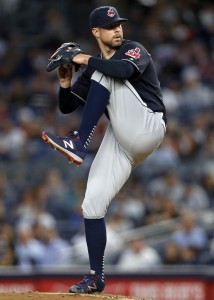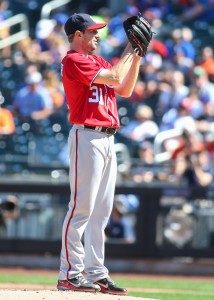The Yankees and Mariners pulled off a blockbuster trade on Monday, when New York sent three prospects – including left-hander Justus Sheffield – to Seattle for southpaw James Paxton. But before that deal went down, there was a possibility of the Yankees returning Sheffield to the Indians, his first professional organization.
Paul Hoynes of cleveland.com reports the Indians likely could have accepted a Sheffield-fronted package for any of Corey Kluber, Carlos Carrasco and Trevor Bauer, whom they’ve discussed with the Yankees. In the end, however, the two sides couldn’t match up, as Hoynes writes that the Mariners placed a higher value on Sheffield than the Indians did. According to Hoynes, Cleveland still likes Sheffield, whom it chose in the first round of the 2014 draft but later traded to the Yankees in a 2016 deal headlined by reliever Andrew Miller. Still, it’s no surprise that the Tribe elected against trading any of its ace-caliber starters to reunite with the 22-year-old Sheffield.
If Cleveland’s going to move Kluber, Carrasco or Bauer, Hoynes relays that it’ll need to receive a return that would unquestionably help the club stay atop the American League Central, a division it has won three years in a row. Conversely, the Mariners don’t figure to contend in 2019, so they were more willing to accept a future-oriented package for Paxton. In addition to the well-regarded Sheffield, Paxton brought back a pair of non-elite prospects in righty Erik Swanson and outfielder Dom Thompson-Williams.
Even if the Indians were to subtract one of Kluber, Carrasco or Bauer, starting pitching wouldn’t be a weak point for the club, as it also counts Mike Clevinger, Shane Bieber, Danny Salazar and Triston McKenzie among its rotation possibilities. The team’s outfield is an obvious concern, on the other hand, and as Kyle Downing of MLBTR pointed out in previewing the Indians’ offseason, it would make more sense for a Kluber, Carrasco or Bauer trade to net them a cheap, controllable solution in that area.
If the Indians do part with any of their three right-handed stars this offseason, each would warrant a greater return than Paxton. The Big Maple, who’s down to his final two years of arbitration eligibility, hasn’t been as durable as any member of Cleveland’s trio. There’s also a rather strong case to be made that he simply isn’t as good as Kluber, Carrasco or Bauer.
Few have been able to combine dominance and durability like the 32-year-old Kluber dating back to his 2014 breakout. The two-time AL Cy Young winner also comes with up to three years of team control. Kluber’s due $17MM next year, and after that, his employer will have decisions to make on a $17.5MM club option in 2020 and an $18MM option in ’21. Barring major injury issues or a noticeable downturn in performance, those options will be exercised.
Like Paxton, both Carrasco and Bauer have two years of team control left. Carrasco will earn $9MM in 2019 and perhaps another $9.5MM by way of a club option in 2020, though that figure could increase based on AL Cy Young voting. Bauer’s future salaries are less certain than his two teammates’, but he’s projected to earn an affordable sum – $11.6MM – in his second-last year of arbitration eligibility. Although the 27-year-old doesn’t yet have the long-term track record of Kluber or Carrasco, Bauer may have been better than both of them in 2018, when he logged a 2.21 ERA/2.44 FIP with 11.34 K/9 and 2.93 BB/9 in 175 1/3 innings.
It’s unclear whether the Indians will trade any of their three No. 1 starters in the coming months, but their futures will undoubtedly be among the majors’ most interesting storylines this offseason. Kluber, Carrasco and Bauer, along with Noah Syndergaard (Mets), Zack Greinke (Diamondbacks), Madison Bumgarner (Giants) and free agents Patrick Corbin and Dallas Keuchel, appear to be the best starters who have at least some chance to end up on the move prior to the 2019 campaign.

